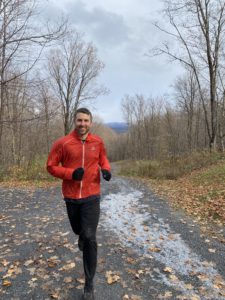Proximal Hamstring Tendinopathy Success Story: Matt’s Journey
Click here for details on the PHT Monthly Membership
 Meet Matt
Meet Matt
Let’s begin by introducing Matt, a 40-year-old French Canadian from Montreal, Canada. Matt’s athletic journey started with competitive cycling and cross-country skiing in his 20s. However, when he hit his early 30s, he decided to shift his focus to running due to time constraints and his growing translation company. Matt’s story highlights how his transition to running ultimately led him to Proximal Hamstring Tendinopathy.
The Onset of Proximal Hamstring Tendinopathy
Matt’s Proximal Hamstring Tendinopathy journey began during a month-long retreat in a mountain village near Montreal. Excited to explore new trails, he significantly increased his training volume, incorporating more hill running, frequent runs, and maintaining his two intense sessions per week. By the third week of the retreat, he started feeling discomfort in his hamstrings, but he decided to push through until the end of the retreat, hoping to recover once he returned home.
One crucial factor in Matt’s PHT development was the significant increase in his training volume during the retreat. He was running more frequently, often doing multiple runs per day, and the high-intensity sessions were taking a toll on his hamstrings. Matt’s story highlights the importance of carefully managing training volume to prevent overloading the hamstrings.
Another factor that Matt pointed out was his experimentation with running form adjustments, particularly a kickback motion. This modification increased the load on his hamstrings, contributing to the development of Proximal Hamstring Tendinopathy. Matt’s experience emphasizes the need to approach form adjustments cautiously, as they can impact muscle and tendon load significantly.
Seeking Professional Help
Matt sought help from multiple physiotherapists to address his Proximal Hamstring Tendinopathy. One key takeaway was the importance of finding a physiotherapist who specializes in running injuries, as proper diagnosis and treatment are crucial. Matt’s initial physiotherapy included light strengthening exercises, which he saw some improvements from. However, he made a common mistake by discontinuing the exercises once his symptoms improved, believing that strength was no longer the issue.
Learning from the Podcast
Matt’s turning point came when he started listening to our podcast, where we discussed PHT directly. He realized that he needed to change his approach. One major shift was his decision to embrace the discomfort and not shy away from pain during exercises.
To combat PHT, Matt took a proactive approach and began heavy lifting at the gym. His regimen included squats, deadlifts, single-leg deadlifts, stiff-leg deadlifts, split squats, step-ups, and eccentric Swiss ball hamstring curls. Matt’s emphasis on heavy, progressive strength training was a game-changer in his recovery journey.
Matt highlighted the need to progressively increase strength and capacity, even if it meant experiencing some soreness during workouts. This approach helped him overcome PHT and regain full strength and function in his hamstrings.
Proximal Hamstring Tendinopathy Lessons
Matt’s physiotherapist advised him to self-manage his running and monitor his pain levels. He was instructed never to push past a three out of ten pain level during runs and to adjust his training volume if soreness persisted. This approach helped Matt balance his running and recovery effectively.
The Role of Uncomfortable Exercises for Proximal Hamstring Tendinopathy
Incorporating uncomfortable exercises was a key strategy in Matt’s recovery. He found that the exercises that challenged him the most were the most beneficial. He recommended choosing exercises that are tolerable during and after workouts as a guide for exercise selection.
Exercise Prescription and Diversity
Matt’s exercise routine covered a wide range of movements, targeting different aspects of hamstring strength. One exercise that wasn’t included but could be valuable is the prone hamstring curl, which isolates the tendon and fosters compression. However, exercise prescription should align with individual goals and needs.
Balancing Exercise Frequency
Matt initially performed all his exercises twice a week but adjusted his frequency as the workouts became more intense. This highlights the importance of finding the right balance between exercise frequency and intensity to avoid overloading the hamstrings.
Conclusion
Matt’s journey to recovery from proximal hamstring tendinopathy serves as an inspirational story filled with valuable lessons. Embracing discomfort, progressively strengthening the hamstrings, and carefully managing training volume and pain levels were key factors in his success. If you’re dealing with PHT or a similar injury, consider the insights from Matt’s experience as you work towards your own recovery.


